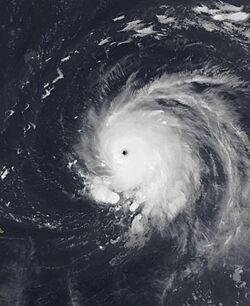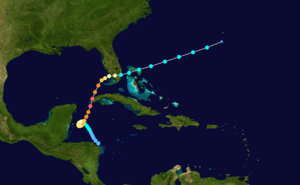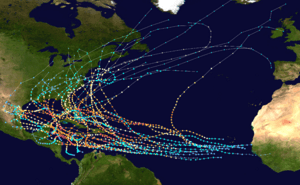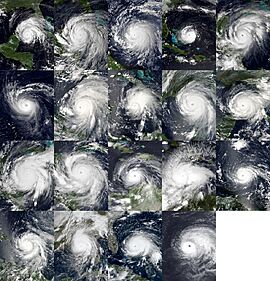List of Category 5 Atlantic hurricanes facts for kids

A Category 5 Atlantic hurricane is a tropical cyclone that reaches Category 5 intensity on the Saffir–Simpson hurricane wind scale, within the Atlantic Ocean to the north of the equator. They are among the strongest tropical cyclones that can form on Earth, having 1-minute sustained wind speeds of at least 137 knots (254 km/h; 158 mph; 70 m/s). The United States National Hurricane Center currently estimates that 11 tropical cyclones between 1851 (the first Atlantic hurricane season to be included in the official Atlantic tropical cyclone record) and 1959 peaked as Category 5 hurricanes. However, because technologies such as satellite monitoring were not available until the 1960s, some such cyclones may have remained undetected. Since 1960, 29 Atlantic hurricanes have reached Category 5.
Background
Within the Atlantic Ocean to the north of the Equator, hurricanes are officially monitored by the United States's National Hurricane Center (NHC), however, other meteorological services, such as Météo-France, the United Kingdom's Met Office and Environment Canada also monitor the basin. Within the region, a Category 5 hurricane is a tropical cyclone which reaches Category 5 status on the Saffir–Simpson hurricane wind scale, that is, a tropical cyclone that has 1-minute mean maximum sustained wind speeds of 137 knots (254 km/h; 158 mph; 70 m/s) or greater at 10 metres (32.8 ft) above ground.
A total of 40 tropical cyclones have been estimated to have peaked as Category 5 hurricanes on the SSHWS, with the first occurrence recorded in 1924. No Category 5 hurricanes were observed officially before 1924. It can be presumed that earlier storms reached Category 5 strength over open waters, but the strongest winds were not measured. Although anemometer, a device used for measuring wind speed, was invented in 1846, during major hurricane strikes the instruments were often blown away or damaged, leaving the hurricane's peak intensity unrecorded. For example, as the Great Beaufort Hurricane of 1879 struck North Carolina, the anemometer cups were blown away when indicating 138 mph (222 km/h).
As of May 2018[update], a reanalysis of weather data was ongoing by researchers who may upgrade or downgrade Atlantic hurricanes. For example, the 1825 Santa Ana hurricane is suspected to have reached Category 5 strength. Furthermore, paleotempestological research aims to identify past major hurricanes by comparing sedimentary evidence of recent and past hurricane strikes. For example, a "giant hurricane" significantly more powerful than Hurricane Hattie (Category 5) has been identified in Belizean sediment, having struck the region sometime before 1500.
Records

Officially, the decade with the most Category 5 hurricanes is 2000–2009, with eight Category 5 hurricanes having occurred: Isabel (2003), Ivan (2004), Emily (2005), Katrina (2005), Rita (2005), Wilma (2005), Dean (2007), and Felix (2007). The previous decades with the most Category 5 hurricanes were the 1930s and 1960s, with six occurring between 1930 and 1939. The most Category 5 hurricanes recorded in a single season is four, in 2005. The most consecutive years to feature at least one Category 5 hurricane each is four, from 2016 to 2019.
Nine Atlantic hurricanes—Camille, Allen, Andrew, Isabel, Ivan, Dean, Felix, Irma and Maria—reached Category 5 intensity on more than one occasion; that is, by reaching Category 5 intensity, weakening to a Category 4 status or lower, and then becoming a Category 5 hurricane again. Such hurricanes have their dates shown together. Camille, Andrew, Dean, Felix, Irma, and Maria each attained Category 5 status twice during their lifespans. Allen, Isabel, and Ivan reached Category 5 intensity on three separate occasions. The 1932 Cuba hurricane holds the record for the most time spent as a Category 5 hurricane (although it took place before satellite or aircraft reconnaissance, so this record may be somewhat suspect). Irma holds the record for the longest continuous span as a Category 5 storm in the satellite era.
Of the 40 Category 5 Atlantic hurricanes on record, 1 has been recorded in July, 8 in August, 22 in September, 6 in October, and 1 in November. There have been no officially recorded June or off-season Category 5 hurricanes.
The July and August Category 5 hurricanes reached their high intensities in both the Gulf of Mexico and the Caribbean. These are the areas most favorable for tropical cyclone development in those months.
September sees the most Category 5 hurricanes, with over half of the total. This coincides with the climatological peak of the Atlantic hurricane season, which occurs in early September. September Category 5s reached their strengths in any of the Gulf of Mexico, Caribbean, and open Atlantic. These places are where September tropical cyclones are likely to form. Many of these hurricanes are either Cape Verde hurricanes, which develop their strength due to a long track over warm waters, or else intensify over the warm Loop Current in the Gulf of Mexico.
All but one of the Category 5 hurricanes in October and November (the exception being Michael) reached their intensities in the western Caribbean, a region that Atlantic hurricanes strongly gravitate toward late in the season. This is due to the climatology of the area, which sometimes has a high-altitude anticyclone that promotes rapid intensification late in the season, as well as warm waters.
Systems
| Name | Dates at Category 5 intensity |
Duration at Category 5 intensity |
Peak intensity | Areas affected | Damage (USD) |
Deaths | Refs | |
|---|---|---|---|---|---|---|---|---|
| Wind speed | Pressure | |||||||
| "Cuba" | October 19, 1924 | 12 hours | 165 mph (270 km/h) | 910 hPa (26.87 inHg) | Central America, Mexico, Cuba Florida, The Bahamas |
90 | ||
| "San Felipe II Okeechobee" |
September 13–14, 1928 | 12 hours | 160 mph (260 km/h) | 929 hPa (27.43 inHg) | Lesser Antilles, The Bahamas United States East Coast, Atlantic Canada |
$100 million | 4,000 | |
| "Bahamas" | September 5–6, 1932 | 1 day | 160 mph (260 km/h) | 921 hPa (27.20 inHg) | The Bahamas, Northeastern United States | 16 | ||
| "Camagüey" | November 5–8, 1932 | 3 days 6 hours | 175 mph (280 km/h) | 915 hPa (27.02 inHg) | Lesser Antilles, Jamaica, Cayman Islands Cuba, The Bahamas, Bermuda |
$40 million | 3,103 | |
| "Cuba–Brownsville" | August 30, 1933 | 12 hours | 160 mph (260 km/h) | 930 hPa (27.46 inHg) | The Bahamas, Cuba, Florida Texas, Tamaulipas |
$27.9 million | 179 | |
| "Tampico" | September 21, 1933 | 12 hours | 160 mph (260 km/h) | 929 hPa (27.43 inHg) | Jamaica, Yucatán Peninsula | $5 million | 184 | |
| "Labor Day" | September 3, 1935 | 18 hours | 185 mph (295 km/h) | 892 hPa (26.34 inHg) | The Bahamas, Florida, Georgia The Carolinas, Virginia |
408 | ||
| "New England" | September 19–20, 1938 | 18 hours | 160 mph (260 km/h) | 940 hPa (27.76 inHg) | Eastern United States, Southwestern Quebec | $306 million | 682 | |
| "Great Atlantic" | September 13, 1944 | 18 hours | 160 mph (260 km/h) | 918 hPa (27.11 inHg) | Eastern United States, Atlantic Canada | $100 million | 300 | |
| Carol | September 3, 1953 | 12 hours | 160 mph (260 km/h) | 929 hPa (27.43 inHg) | Bermuda, New England, Atlantic Canada | $2 million | 5 | |
| Janet | September 27–28, 1955 | 18 hours | 175 mph (280 km/h) | 914 hPa (26.99 inHg) | Lesser Antilles, Central America | $65.8 million | 1,023 | |
| Esther | September 17, 1961 | 18 hours | 160 mph (260 km/h) | 919 hPa (27.14 inHg) | East Coast of the United States | $6 million | 7 | |
| Hattie | October 31, 1961 | 6 hours | 165 mph (270 km/h) | 914 hPa (26.99 inHg) | Central America | $60.3 million | 319 | |
| Inez | September 28–29, 1966 | 1 day | 165 mph (270 km/h) | 927 hPa (27.37 inHg) | Greater Antilles, Florida, Mexico | $229 million | 756 | |
| Beulah | September 20, 1967 | 6 hours | 160 mph (260 km/h) | 921 hPa (27.20 inHg) | The Caribbean, Mexico, Texas | $208 million | 59 | |
| Camille | August 16–18, 1969 | 1 day 6 hours | 175 mph (280 km/h) | 900 hPa (26.58 inHg) | Cuba, United States Gulf Coast | $1.42 billion | 259 | |
| Edith | September 9, 1971 | 6 hours | 160 mph (260 km/h) | 943 hPa (27.85 inHg) | The Caribbean, Central America Mexico, United States Gulf Coast |
$25.4 million | 37 | |
| Anita | September 2, 1977 | 12 hours | 175 mph (280 km/h) | 926 hPa (27.34 inHg) | Mexico | Unknown | 11 | |
| David | August 30–31, 1979 | 1 day 18 hours | 175 mph (280 km/h) | 924 hPa (27.29 inHg) | The Caribbean, United States East coast | $1.54 billion | 2,068 | |
| Allen | August 5–9, 1980 | 3 days | 190 mph (305 km/h) | 899 hPa (26.55 inHg) | The Caribbean, Yucatán Peninsula Mexico, South Texas |
$1.57 billion | 269 | |
| Gilbert | September 13–14, 1988 | 1 day | 185 mph (295 km/h) | 888 hPa (26.22 inHg) | Jamaica, Venezuela, Central America Hispaniola, Mexico |
$2.98 billion | 318 | |
| Hugo | September 15, 1989 | 6 hours | 160 mph (260 km/h) | 918 hPa (27.11 inHg) | The Caribbean, United States East Coast | $10 billion | 107 | |
| Andrew | August 23–24, 1992 | 16 hours | 175 mph (280 km/h) | 922 hPa (27.23 inHg) | The Bahamas, Florida, United States Gulf Coast | $26.5 billion | 65 | |
| Mitch | October 26–28, 1998 | 1 day 18 hours | 180 mph (285 km/h) | 905 hPa (26.72 inHg) | Central America, Yucatán Peninsula, South Florida | $6.08 billion | 11,374 | |
| Isabel | September 11–14, 2003 | 1 day 18 hours | 165 mph (270 km/h) | 915 hPa (27.02 inHg) | Greater Antilles, Bahamas Eastern United States, Ontario |
$5.37 billion | 51 | |
| Ivan | September 9–14, 2004 | 2 days 12 hours | 165 mph (270 km/h) | 910 hPa (26.87 inHg) | The Caribbean, Venezuela, United States Gulf Coast | $23.3 billion | 124 | |
| Emily | July 16, 2005 | 6 hours | 160 mph (260 km/h) | 929 hPa (27.43 inHg) | Windward Islands, Jamaica, Mexico, Texas | $1.01 billion | 17 | |
| Katrina | August 28–29, 2005 | 18 hours | 175 mph (280 km/h) | 902 hPa (26.64 inHg) | Bahamas, United States Gulf Coast | $125 billion | 1,836 | |
| Rita | September 21–22, 2005 | 1 day | 180 mph (285 km/h) | 895 hPa (26.43 inHg) | Cuba, United States Gulf Coast | $12 billion | 125 | |
| Wilma | October 19, 2005 | 18 hours | 185 mph (295 km/h) | 882 hPa (26.05 inHg) | Greater Antilles, Central America, Florida | $29.4 billion | 87 | |
| Dean | August 18–21, 2007 | 1 day | 175 mph (280 km/h) | 905 hPa (26.72 inHg) | The Caribbean, Central America | $1.76 billion | 45 | |
| Felix | September 3–4, 2007 | 1 day | 175 mph (280 km/h) | 929 hPa (27.43 inHg) | Nicaragua, Honduras | $720 million | 133 | |
| Matthew | October 1, 2016 | 12 hours | 165 mph (270 km/h) | 934 hPa (27.58 inHg) | Antilles, Venezuela, Colombia United States East Coast, Atlantic Canada |
$15.1 billion | 603 | |
| Irma | September 5–9, 2017 | 3 days | 180 mph (285 km/h) | 914 hPa (26.99 inHg) | Cape Verde, The Caribbean, Virgin Islands Cuba, Florida |
$64.8 billion | 138 | |
| Maria | September 18–20, 2017 | 1 day 4 hours 15 minutes |
175 mph (280 km/h) | 908 hPa (26.81 inHg) | Lesser Antilles, Virgin Islands, Puerto Rico Dominican Republic, Turks and Caicos Islands |
$91.4 billion | 3,018 | |
| Michael | October 10, 2018 | 30 minutes | 160 mph (260 km/h) | 919 hPa (27.14 inHg) | Central America, United States Gulf Coast | $25.1 billion | 74 | |
| Dorian | September 1–2, 2019 | 1 day 6 hours | 185 mph (295 km/h) | 910 hPa (26.87 inHg) | The Caribbean, The Bahamas United States East Coast, Atlantic Canada, Greenland |
$5 billion | 84 | |
| Lorenzo | September 29, 2019 | 3 hours | 160 mph (260 km/h) | 925 hPa (27.32 inHg) | Cabo Verde, Azores, Western Europe | $367 million | 20 | |
| Ian | September 28, 2022 | 6 hours | 160 mph (260 km/h) | 937 hPa (27.67 inHg) | Caribbean, Cuba, Florida, The Carolinas | $113 billion | 160 | |
| Lee | September 8, 2023 | 6 hours | 165 mph (270 km/h) | 926 hPa (27.34 inHg) | Bermuda, New England, Atlantic Canada | $50 million | 4 | |



